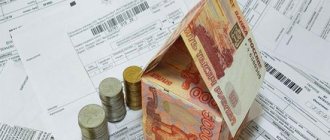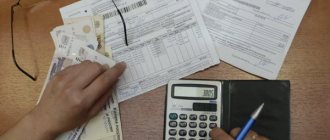Electricity
If you use the simplest - single-tariff - calculation system, then you need to fill out the first three fields and leave the rest empty. With a two-tariff system - the first six. If you have a three-tariff system and the calculations take into account the half-peak tariff, then you need to fill out all the fields and then click “calculate”. Electricity tariffs can be found in your management company, online on official regional websites or on our website in the Tariffs section.
If you want to understand how it works, here are the calculation formulas.
In a single-tariff system, the following formula is used.
Pi = ViP x Tcr
Where ViP is the volume (quantity) of electricity consumed during the billing period in residential or non-residential premises. To calculate it, you need to subtract the previous value (those kilowatts for which you have already paid) from the latest meter readings.
Tkr is the regional tariff for electricity supply.
In some regions, the standard for electricity consumption is 150 kW per month. If this indicator is exceeded, then everything that is above the norm is calculated at an increased rate.
If you have a two- or three-tariff system, then we apply the same formula, but we calculate the fees for peak, night and half-peak separately, and then add up the amounts.
Did you know that prototypes of modern calculators existed in Ancient Egypt? And that the first real calculator - a mechanical machine for arithmetic calculations - was invented at the age of 19 by the famous mathematician and physicist Blaise Pascal?
Read the link: History of computing devices, interesting facts, types of calculators.
Google spreadsheet will calculate for you how much to pay according to the meters
Just enter your tariffs and meter readings into the table and get the amount you need to pay for utilities.
Alexander Poyarkov
He runs a blog about small business marketing.
Previously, my wife and I kept track of meter readings in a notebook. Everything had to be counted manually. It takes time, albeit a little. Plus, there is a human factor - you can make mistakes in your calculations.
To eliminate this, we made a table that automatically calculates utility costs. You need to enter tariffs and current meter readings into it. She will calculate everything else for you. Keep it for yourself and use it for your health.
How to use the table
- To start using the table, follow the link and select “Create a copy” from the “File” menu.
- Enter your tariffs for hot and cold water, sewerage, electricity and gas. Tariffs can be set once and extended for all months. If rates increase in price, simply write the new value and drag it down the entire column again.
- Enter your meter readings in the “Act” columns each month. Example: we see the number 200 on the hot water meter - enter it into the table. Everything else follows the same principle.
- Water drainage does not have a “Fact” column, because this indicator is calculated automatically. Wastewater disposal is the total liters of hot and cold water wasted. The table itself adds up this data and multiplies it by the tariff.
- After you have entered the tariffs and readings, the table will calculate how much you need to pay according to the meters this month. You will see the amounts for each service and the total amount as a whole.
Using the table, you can avoid manually counting utility costs and stop keeping a notebook with meter readings. I'm probably not the first to make such a table. If you advise in the comments how this template can be improved, I will be very glad to read it.








